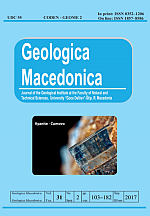EPITHERMAL GOLD MINERALIZATION IN THE KRASSEN DEPOSIT, PANAGYURISHTE ORE DISTRICT, BULGARIA
Abstract
Gold mineralization in the Krassen high-sulphidation epithermal deposit, Panagyurishte ore district, Bulgaria, has been studied in respect to mineral assemblages, gold grain size, fineness and trace elements based on EPMA and LA-ICP-MS studies. Part of the gold in the early massive pyrite dominated ores is submicroscopic in size (< 0.1 µm) and could be attached to the so called “invisible” gold. Later fracturing of the early massive pyrite, followed the deposition of Cu-pyrite ore bodies enriched in chalcopyrite, enargite, bornite, galena and sphalerite accompanied by deformation and recrystallization is suggested as a reason for Au and Ag migration to cracks and gold grains coarsening. The electrum fineness in individual grains varies between 882 and 998 ‰. Most commonly observed trace elements in the native gold, electrum grains and gold hosting sulphide minerals are: Cu, Fe, Hg, Sb, Te, Bi, As and Se. The Au content in pyrite varies from 0.35 to 7.83 ppm and in chalcopyrite from 0.97 to 2.78 ppm. BiTe-Se and Ga-Ge-In trace elements signature is characteristic feature of the ore minerals and indicator for Au enrichment.




